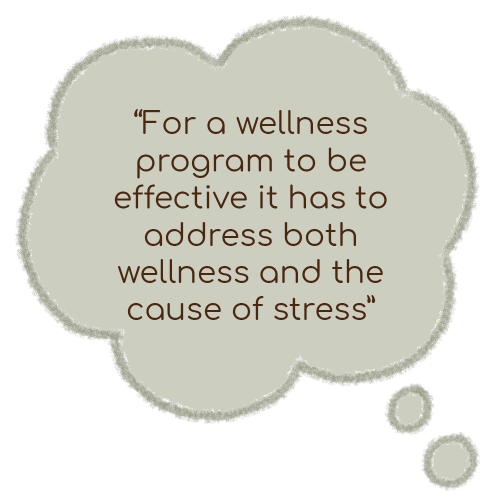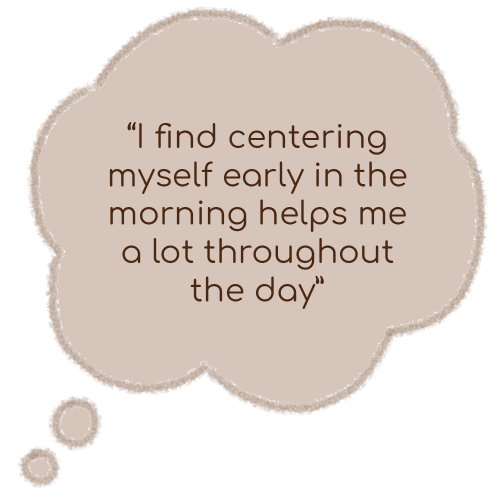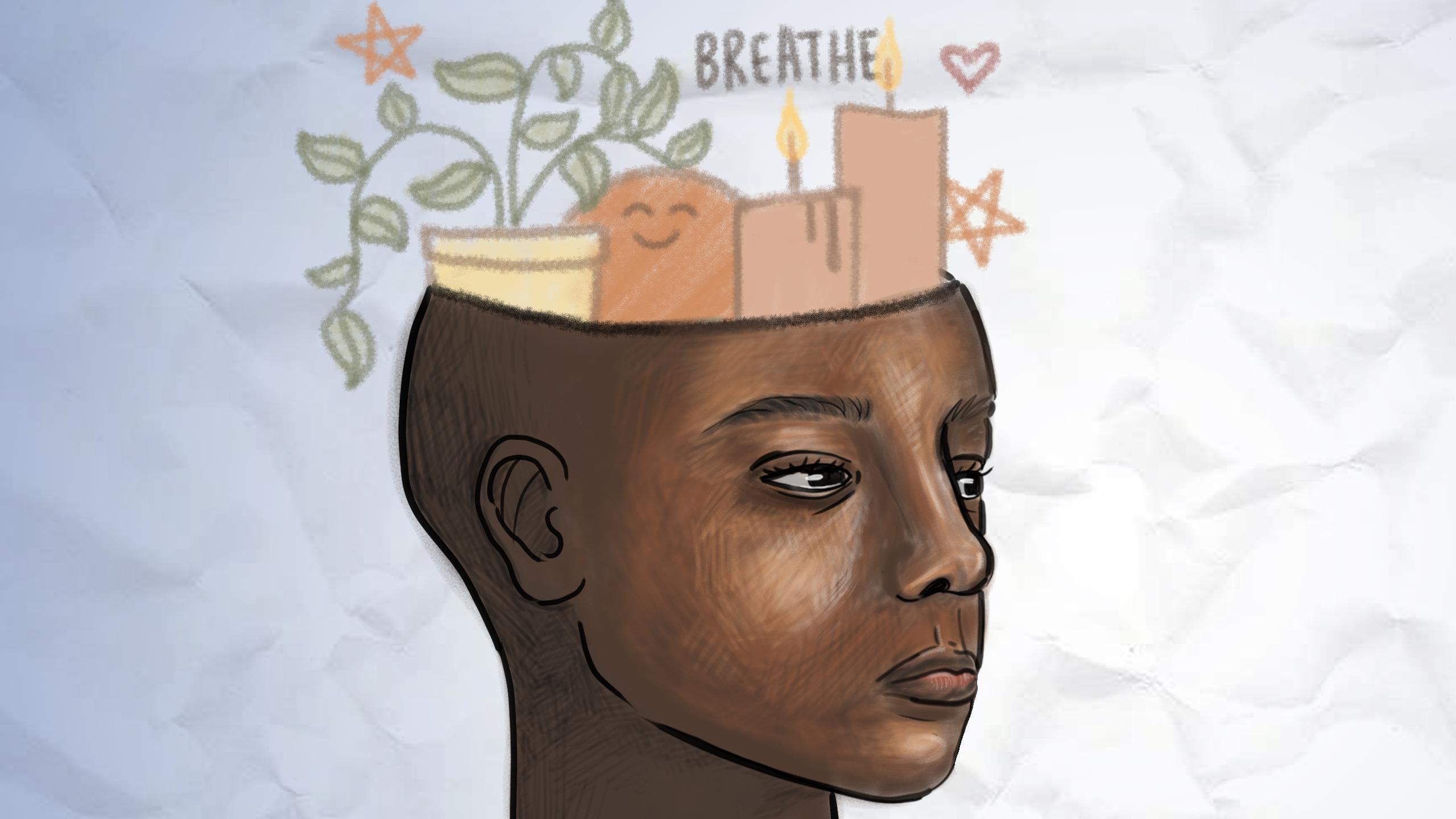Universities often have no shortage of wellness resources but mindfulness isn’t a blanket solution.
By Simran Singh
Illustrations by Jes Mason
CONTENT WARNING: This article discusses mentions of suicide and student death.
Three years ago, fourth-year journalism student Santiago Ramer was watching the trains go by at Union Station when he found himself yet again thinking that maybe the world was better off without him and all his problems would go away if he ended his life right there.
Having dealt with these sorts of thoughts since he was a child, Ramer was diagnosed with depression and passive suicidal ideation that year. Passive suicidal ideation is when one thinks about self-harm without a specific plan or intent to carry it out. This means that although Ramer experiences suicidal thoughts, he has never acted upon them.
“Those thoughts are always sitting in the back of my mind, so when times get tougher [they] tend to get louder,” says Ramer.
When he sat down on his GO train that day three years ago, he told himself that he needed to do something about his mental health. Ramer spent the rest of that weekend researching different mental health services offered on campus that he could access without the help of his parents.
Ramer noticed a lot of Ryerson promotion of mental health awareness without any real direction on how to access services or what would serve him best. Although he was able to get academic accommodation for his Attention Deficit Hyperactivity Disorder (ADHD), he felt lost as to where he could go and seek help.
Every time he’d try to reach out to a Ryerson administrator, they’d point him to the same list of services he’d found online. Simply showing up and asking for help was difficult for him. He was concerned about the stigma surrounding mental health issues, especially as a man—something he still struggles with.
Ramer says he knew that his program and the university had good intentions to support him in the best way they could, but it wasn’t enough.
When Ramer felt like his mental health was affecting his school work, his program advisor told him to reach out to academic accommodations on the fourth floor of the Sheldon & Tracy Levy Student Learning Centre (SLC). However, he found himself waiting over an hour to speak to an academic coordinator—an obstacle he seemed to encounter often during future visits.
A friend of a friend recommended that he visit the Ryerson Students’ Union (RSU) to learn more about counselling services that are offered on campus. Ramer stood in line for 45 minutes, completing a podcast episode while he was waiting for his turn.
Fed up by the long wait time, he wondered if attempting to find support for his mental health on campus would be worth it. By the time he was four spots away from the front desk, he looked back and realized how many other students were standing in line behind him for the same reason. At that point, he decided to walk out of the line and take matters into his own hands.

Although he was able to receive academic accommodations to help him succeed in his school work, he had to begin looking for mental health support off-campus.
This spring, Ramer started doing yoga when COVID-19 cases began to rapidly increase and the first lockdown was put in place. This was just the beginning of his journey of using mindfulness strategies to maintain his mental health.
Amidst the hustle and bustle of modern society and in the peak of a global pandemic, there’s been a rapid increase of mindfulness efforts within post-secondary institutions and workplaces. From the success of best-selling self-help books like, Let That Sh*t Go: A Journal for Leaving Your Bullsh*t Behind and Creating a Happy Life by Monica Sweeney, to meditation apps like Headspace, to the rise of yoga influencers like Yoga With Adrienne, mindfulness activities are gaining traction now more than ever.
According to welldoing.org, some mindfulness practices date back 2,500 years originating with the historical teachings of the Buddha. Gaining wider popularity in the 1970s, mindfulness became well known as a form of meditation and wellness to help people reduce stress.
Today, the line between spirituality and capitalism has blurred to create a new age definition of mindfulness. According to an article in Psychology Today, companies that encourage mindfulness among their employees may not actually provide “tangible and practical considerations” like living wages, family leave plans and retirement benefits to treat their employees better. Author of the article, Thomas G. Plante, a psychology professor at Santa Clara University says a corporation’s message may as well be, “if you’re not happy, meditate, but don’t complain.”
Ryerson has several of its own wellness programs, like Thriving in Action, developed to help students grow academically and personally using mindfulness techniques like the “three minute calming breath.” Students can also engage with therapy dogs every Wednesday through Zoom from 12 p.m. to 1 p.m. and take part in activities like mindful colouring that have previously been offered on a faculty and program level.
But Ryerson’s mental health resources aren’t as accessible as they are numerous. As of October of last year, some Ryerson students had to wait several months to land an appointment at Ryerson’s Centre for Student Development and Counselling (CSDC).
In March 2019, 100 students gathered outside the University of Toronto’s (UofT) Simcoe Hall to demand urgent attention from their university on mental health in light of yet another student suicide and UofT’s “mental health crisis.” In March 2020, the University of Ottawa confirmed the sixth student death over the past year in relation to mental health concerns. The Fulcrum and The Varsity, student papers at UOttawa and U of T, respectively, subsequently reported on how these crises stem from systemic and institutional problems with how universities address mental health.
When it comes to addressing a systemic student mental health crisis, investment in wellness programs may not be enough on the part of universities. Mindfulness can be a helpful tool for student wellbeing, but institutions need to keep in mind that it’s not a blanket solution for everyone.
According to Canada research chair in occupational health psychology at Saint Mary’s University, Kevin Kelloway, if companies and schools are asking too much of employees and students and putting them in stressful situations, the answer is not necessarily mindfulness. The problem is organizational, so the solution would instead be to change what the organization is doing.
Kelloway says when it comes down to the mental health of students, mindfulness itself isn’t the problem because stress is a function of the person as well as the situation.
“So for a wellness program to be effective it has to address both [wellness and the cause of stress],” he says. “And too often, in my view, we say ‘Oh, well, let’s fix the person.’”

hayla* and her parents have never seen eye to eye when it comes to her life decisions. Whether it was her degree, or the university she wanted to attend, or even the sports she tried to partake in, they always disagreed.
Shayla’s parents were adamant she live at home while attending the University of Windsor, so they could have full supervision over her. Even though she was forced to stay home, Shayla still chose to enroll in business administration, against her parent’s wishes that she pursue medicine. Shayla felt unsafe in her family environment and was diagnosed with anxiety and depression that same year.
Shayla’s mental health worsened while attending UWindsor as it wasn’t the school she originally wanted to attend. To support her mental health, she decided to try the mental health services offered on her campus.
Shayla attended a yoga class that was offered by the university to help students destress and learn about mindfulness through yoga. She went with a friend and was already anxious and felt out of place prior to entering the class.
She didn’t expect to see so many people and immediately felt uncomfortable. The large group of more than 30 students led Shayla to overthink her reasons for being there. Were people judging her? Was she doing the poses correctly?
“I honestly didn’t find those helpful, I had to leave halfway [through the class],” she says.
“I feel like [yoga] works for some people, but not for everyone.”
Kelloway says companies will spend a lot of money providing discounted gym or yoga memberships to their employees to promote good health and wellness. However, not everyone is going to find these company benefits to be useful for their mental health because not everyone is interested in partaking in these activities for mindfulness.
According to an article in BBC Worklife, companies are investing large amounts of money into mindfulness programs, but this can backfire when it comes to employee motivation. Mindfulness is about accepting the present moment—but in work environments, moving past challenges isn’t effective when there are targets and deadlines to meet. In this way, mindfulness becomes a challenge for employees, rather than a solution.
By the end of first-year, Shayla decided to transfer to Ryerson’s business management program, the program she wanted to pursue in the first place. However, her parents have no idea.
With classes being completely online at Ryerson during the fall semester, it’s relatively easy for Shayla to keep this from her parents. But while she’s able to attend the school she wants to, her parents still have control over a lot of other aspects of her life—something that continues to take a toll on her mental health.
When Shayla’s doctor recommended that she try mindful walking and meditation to reduce her anxiety and depression, Shayla felt that her attempts weren’t getting her anywhere.
“I feel like mindfulness, or meditating doesn’t really get rid of the situation, it doesn’t change how [things are]. And even if it makes me feel a little bit better, that’s only because I’m trying not to think about it.”
Spiritual experts like the author of The Power of Now, Eckhart Tolle, often say that mindfulness comes from within. However, the ideology that the individual needs to adapt to their situation can be one that comes from a place of privilege according to Ronald E. Purser, author of McMindfulness: How Mindfulness Became The New Capitalist Spirituality. He says focusing on the now isn’t going to help those who experience day to day problems that are often out of their control.
For Shayla, removing herself from a situation that gives her stress is what helps her most with her anxiety and depression at the moment. She’s still figuring out what is the best way to take care of her mental health.
She generally prefers to reach out to her friends and talk out her problems. And instead of meditation and yoga, she would attend kick-boxing classes prior to COVID-19.
Where yoga often resulted in Shayla overthinking, she says that fast-paced high intensity workouts help her exude a lot of her physical energy and feel more in tune with her mind and body.

ear the end of her first-year, Amtoj Kaur was in the process of transitioning from her major of medical physics to mathematics. Kaur commutes to Ryerson from Etobicoke where a round trip takes up to four hours during rush hour.
She says her commutes on the TTC were a big part of her negative experiences with university and mental health. They burnt her out to the point where she had no motivation to stay at school for any longer than she needed to.
“Every time I [came] to school, it felt like a lot of work. Traveling for four hours a day to come to a one hour class was not motivating me,” she says. “I didn’t want to be on campus at all and I wanted to take whatever chance I could get to just go home, so that meant that I wasn’t very active on campus.”
The Eyeopener previously reported on a study that found 48 per cent of students surveyed believed their commute was a barrier to their co-curricular experience and 60 per cent of students said their commute discouraged them from participating in campus activities and events.
During the summer of 2019, Kaur realized she wanted to make the best of her university experience and was determined to change her outlook on stress and anxiety.
One day, Kaur was on Ryerson’s main website when she found a post about the school’s Thriving in Action program. It aims to help students succeed by learning strategies to cultivate motivation, optimism, resilience and time management. These were exactly the skills Kaur was looking to learn about.

The form to sign up consisted of a preliminary survey to help students get the most out of the program. One of the questions on the survey included: “Do you enjoy coming to campus?” The answer to her was clear, and she responded honestly: “No.”
“That survey gave me a chance to realize that I wasn’t having the best time in university,” she says. “It made me feel optimistic, like I didn’t have to go through all this alone.”
Thriving in Action was created in 2017 by clinical psychologist, Dr. Diana Brecher, and coordinator of student transitions and retention, student wellbeing, Dr. Deena Kara Shaffer. The program is a weekly cohort that was created to help students from second semester onwards use mindful practices to thrive both academically and personally.
It takes place over the course of 10 weeks and is set in a classroom where students learn the importance of sleep, resilience, group work, holistic learning strategies and self-reflection.
Dr. Brecher says there are important differences between clinical psychology and positive psychology. The goal of clinical psychology is to diagnose, treat and help people get back to their previous level of functioning, whereas positive psychology is meant to help people flourish, which is one of the main premises of Thriving in Action.
“I’m teaching skills to people to keep themselves well and if they experience setbacks…how to regroup much more quickly with less effort so it doesn’t cost as much,” says Dr. Brecher.
While attending Thriving in Action, Kaur learned that her signature strength was team work. Since she never wants to let her team down during group projects, she excels most in teamwork.
Dr. Brecher and Dr. Shaffer saw this as a great way to teach Kaur about how she could turn her independent work into a team project. They taught her to think about her independent assignments as a team effort between herself and her professor. Just like a team member, her professor is counting on her to do a good job and have her work submitted on time.
According to an article in coach.nine.com, mindful practices can be more beneficial to those who have the support of a teacher or a form of guidance. Oftentimes, people who struggle with mindfulness suffer from serious cases of depression and anxiety and without appropriate guidance, mindful practices can exacerbate symptoms.
Thriving in Action has helped Kaur create better habits for time management and build a positive outlook towards problems she can’t control such as her long commutes. The program has also encouraged Kaur to join different student groups and clubs like the Ryerson French club and the University Consulting Group (UCG).
Her success with Thriving in Action led to her getting a job with the program as a Thrive RU Program Assistant. Kaur says that Thriving in Action shaped what she thought about mindfulness in a positive way where she makes a conscious effort to make time for the things she enjoys.
“Something else I take into consideration now is, no matter what, I’m always going to try to make time for things that I enjoy because I’ve learned through these workshops that it’s a good way to always stay motivated,” says Kaur.

amer continued his wellness journey this summer with the help from the character Aang from the animated series, Avatar the Last Airbender.
In one episode, the character Azula shoots Aang in the back with lightning, causing Aang to lose his ability to connect with the defense mechanism known as the Avatar state. In order for Aang to master the avatar state, he was taught by the character Guru Pathik to use meditation to unlock his chakras. Ramer found inspiration from Aang because of the focus it took to unleash him from a problem that was holding him back.
Chakra healing originates from Hinduism and tantric parts of Buddhism and is commonly practiced in yoga and meditation.
In playing the episode back, he felt like the monk’s teachings in the show resonated with him. Like Aang, Ramer felt lost and frustrated in dealing with his issues. But in rewatching the clip of that moment in the show, he found some clarity.
Since learning more about chakras, Ramer has incorporated meditation and yoga into his daily morning routine.
“I find centering myself early in the morning helps me a lot throughout the day,” says Ramer.
Ramer has become more and more open about his mental health and his wellness journey by sharing his story with colleagues and friends and advocating for mental health. He says that he hopes that in sharing his story, it will encourage more young men to feel comfortable to speak up about their mental health.
He’s aware that although mindfulness may not be perfect when it comes to dire problems, Ramer finds yoga and meditation to be beneficial in maintaining his mental health. While these strategies help him on an individual level, he believes corporations can improve the way they show and provide support for the wellbeing of their employees.
“Institutions should try and have more of an emphasis on individual mindfulness and making sure that everyone on their payroll is putting their mental health first over the company.”
*Source’s last name has been omitted for privacy










Harold A Maio
—-He was concerned about the stigma that mental health issues carry
More realistically, he ought be concerned about those taught and teaching that. Their control over his mind matters.
Harold A Maio, retired mental health editor